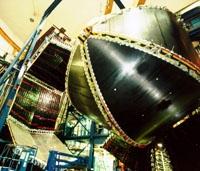Experimental Nuclear and Particle Physics
The Department of Physics has an active and widely recognized program in Nuclear and Particle Physics. The majority of our present experimental programs is focused at Jefferson Laboratory in Newport News, Virginia, which is an international center for nuclear physics research. In addition, we are engaged in a program of fundamental physics using cold neutrons at Los Alamos and Oak Ridge national Laboratories.

The Department of Physics has an active and widely recognized program in Nuclear and Particle Physics. The majority of our present experimental programs is focused at Jefferson Laboratory in Newport News, Virginia, which is an international center for nuclear physics research. In addition, we are engaged in a program of fundamental physics using cold neutrons at Los Alamos and Oak Ridge national Laboratories.
At Jefferson Lab, we are embarking on an ambitious experimental program that will search for the "heavy photon", a partner to the photon and a dark matter candidate. The heavy photon search (HPS) experiment will use an uncommonly small, almost table top, detector at the intensity frontier in particle physics.
We also lead a program at Jefferson Lab for studying the structure of the nucleon through spin-dependent observables. As part of this effort, we are analyzing the data from the recently completed g2p experiment, which should shed light on the so called `Proton Radius Puzzle'. Our group is is also at the forefront of an exciting new effort to measure Tensor Spin Observables using a novel tensor polarized target.
At Los Alamos and Oak Ridge we are collaborating on experiments using newly available beams of very slow neutrons to study the properties of the neutron itself. These experiments are sensitive to the fundamental interaction between the constituent quarks within the neutron and to the fundamental interaction leading to its beta decay to become a proton.
We had a major role in the design, construction, and commissioning of a major instrument for nuclear and nucleon physics called BLAST. It used the 1 GeV electron beam at the Bates accelerator as a means to examine matter and fields on a scale ten thousand times smaller than the atom. The BLAST detector has now been disassembled and shipped to Germany, where it was used in the Olympus experiment at DESY.
Professors: John Calarco, Maurik Holtrop, Karl Slifer, Patricia Solvignon